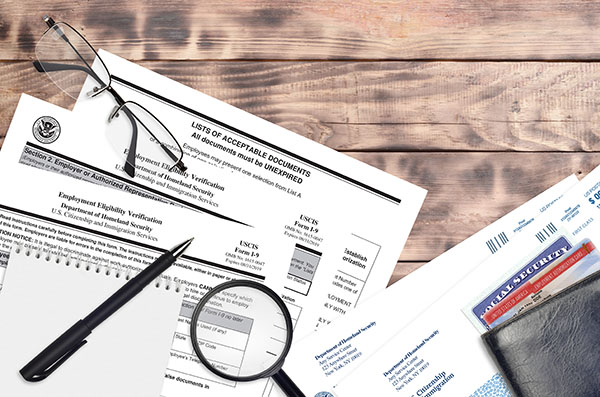Employer's Report: Employers Report Post
Read our CEA monthly newsletter, curated and written by our team of experts.
Missing out on the action?
New Form I-9 and E-Verify Updates
Posted by Eli Nuñez, HR Director on April 10, 2025
Tags: Compliance
On April 2, 2025 U.S Citizenship and Immigration Services (USCIS) announced some minor changes to Form I-9 and E-Verify. The previous update to the I-9 form was released in August 2023 and marked a drastic departure from previous versions. The new changes are minor in comparison, but still important to pay attention to.
2025 Updates to Form I-9
The new changes to Form I-9 align with the ideology and policies of the current administration:
- The fourth checkbox in Section 1 has been changed from “A noncitizen authorized to work” to “An alien authorized to work.”
- The descriptions for two List B documents in the list of Acceptable Documents (Driver’s license or ID card) have been updated by removing the word “gender” and replacing it with the word “sex”
The USCIS also added some new statutory language and a revised Department of Homeland Security (DHS) Privacy Notice to the instructions for completion of the form.
The new form has an edition date of 1/20/2025 and an expiration date of 5/31/2027, which is the same as the last version.
As a best practice, employers should begin using the new form immediately to avoid accidentally using an expired version in the future.
2025 Changes to E-Verify
Since the I-9 process and E-Verify tend to work hand in hand, the changes to E-Verify mirror the updates to the I-9 form.
Changes for employers who utilize E-Verify to confirm employment eligibility include:
- Employers must now select “An alien authorized to work” in E-Verify if the employee attests to being a non-citizen with work authorization
- Any existing cases have been updated to the new terminology (“An alien authorized to work”)
- Employers participating in E-Verify+ will see the updated edition date of 1/20/2025 and expiration date of 5/31/2027 reflected on form I-9NG
Next Steps for Employers
Employers should always use the most recent I-9 form when verifying the identity and employment authorization of new employees. Keep in mind it is not necessary to go back and replace all your current employees’ I-9 forms with the new version.
Once you have established an employee’s work authorization, there is no need to re-verify unless:
- Their employment authorization expires
- You are rehiring an employee within 3 years of the date of their previous I-9
- You receive reliable notice that an employee’s authorization is deficient. This could come in the form of a written notice from Immigration and Customs Enforcement (ICE) or USCIS.
U.S. citizens and Noncitizen Nationals are automatically eligible for employment, therefore, there is no need to re-verify their authorization. The same is true for permanent residents.
Auditing Your I-9 Forms
The current administration’s emphasis on immigration enforcement could create a risk for employers who have not paid close attention to the employment verification process. Now is a great time to audit your I-9s and proactively address any issues.
Additional Resources
CEA has partnered with Cascade Employers Association to offer a FREE downloadable resource 2025 USCIS Immigration Employment Guide, available to all employers. Or join CEA on Thursday, May 1, 2025, for I-9 Best Practices: What Employers Need to Know. Webinar attendees will learn the critical requirements of the I-9 form, including proper completion, verification, and the retention process. Our Subject Matter Experts will cover common mistakes employers make and offer strategies for preventing issues related to document errors or omissions. The course also addresses some of the specific challenges employers face, such as handling remote hires and re-verifying employees.
CEA Members who are not sure where to start have access to our I-9 Self Audit Toolkit. This easy-to-follow tool kit walks you through getting started, document retention, how to correct errors, and addressing missing information step by step with links to resources, fact sheets, and work sheets to help make your I-9 forms compliant. Or, CEA Members can call on our team of HR Advisors who can assist your company with I-9 audits, Harassment Prevention Training, and other resources. Give us a call at 800.399.5331 to get started.
Hot Training Topics for April & May
Posted by California Employers Association on April 1, 2025
Tags: Training & Development
In addition to important compliance topics like Mandated Reporter, Wage & Hour and Employee Handbooks, and Leaves of Absences in California, there are a few recently added trainings addressing hot-button issues in the news. Join us for on April 10 for a FREE Immigration Enforcement and Handling ICE Visits in partnership with The Grady Firm. Then join us again on May 1 and follow up to learn about I-9 Best Practices.
Don’t Skip Steps: PAGA “Reasonable Steps” That Is
Posted by Laura McHugh & Katie Collins, Duggan McHugh Law Corp. on April 1, 2025
Tags: Compliance
As businesses advance into the second quarter of the year, ensuring compliance with the California Labor Code must remain a top priority-particularly in light of the recent reforms to the Private Attorneys General Act (PAGA). These changes present a critical opportunity for employers to take proactive measures, safeguarding against costly Labor Code violations and mitigating exposure to substantial PAGA penalties.
Since its enactment in 2004, PAGA has been a legal minefield for employers, often leading to expensive litigation, operational disruptions, and lingering uncertainty. Even seemingly minor infractions-such as a slight error in the suite number on an employee’s pay stub-can result in significant penalties. However, with the recent reforms, employers now have a comprehensive roadmap to reduce their risk by taking all reasonable steps to ensure compliance with California’s labor laws.
What are Reasonable Steps?
Under the updated PAGA framework, employers can substantially limit their liability by implementing proactive measures designed to comply with the Labor Code. These reasonable steps include, but are not limited to:
- Conducting Periodic Payroll Audits: Regularly reviewing payroll records to identify and correct compliance issues before they escalate into larger, costlier problems.
- Disseminating Clear, Lawful Policies: Ensuring all policies related to wages, rest and meal breaks, overtime, and other key areas are properly documented and effectively communicated to employees.
- Training Supervisors: Educating management and supervisory staff on Labor Code requirements and wage orders to ensure the consistent and correct enforcement of workplace policies.
- Taking Prompt Corrective Action: Addressing any instances of non-compliance by supervisors swiftly to prevent systemic issues and reduce the risk of legal exposure.
The Payoff: Significantly Reduced Penalties
Employers who take these “reasonable steps” prior to receiving a PAGA notice or a request for employment records can cap the PAGA penalties to just 15% of the applicable amount recoverable by an aggrieved employee on behalf of the California Labor and Workforce Development Agency (LWDA). Typically-but not always-these penalties are calculated at $100 per pay period, per employee, dating back one year prior to the PAGA notice.
Even in cases where an employer has already received a PAGA notice (for notices dated June 19, 2024, or later), there is still an opportunity to limit liability. By taking all reasonable steps within 60 days of receiving the PAGA notice, employers can cap recoverable penalties to 30% of the applicable amount.
Key Takeaway
If faced with a PAGA lawsuit, employers who take all reasonable steps to address and prevent Labor Code violations within 60 days of receiving the PAGA notice-or, better yet, proactively before any notice is issued-can significantly reduce the scope and potential financial impact of the PAGA claim.
To seize this opportunity, employers should take a proactive approach by:
- Auditing employee handbooks and related wage-and-hour policies to ensure compliance, making revisions as necessary.
- Scheduling and conducting regular payroll audits to identify and resolve any areas of concern.
- Providing comprehensive training for supervisors, who are often the first line of defense in ensuring adherence to lawful practices.
By adopting these measures, employers can avoid the pitfalls of costly legal litigation, minimize penalties, and protect their financial interests. In today’s ever-changing legal landscape, compliance is not merely a recommendation-it is an essential cornerstone of any successful and sustainable business strategy.
 Duggan McHugh is proud to be a CEA Partner. If you have questions about PAGA, or other employment law issues, please contact us, or visit our website dugganmchugh.com
Duggan McHugh is proud to be a CEA Partner. If you have questions about PAGA, or other employment law issues, please contact us, or visit our website dugganmchugh.com
Understanding Employee Expense Reimbursements
Posted by Astrid Servin, PHRca, HR Director & Virginia Young, HR Compliance Director on April 1, 2025
Tags: Compensation, Compliance
Do you have employees? If so, you likely need to provide expense reimbursements. California Labor Code 2802 requires employers to indemnify employees for necessary expenditures and losses incurred in direct consequence of discharge of their duties. Simply put, employers should never pass on their operating costs to employees. Employers know they need to reimburse employees for obvious expenses like work-related travel, but what about less common expenses?
Test Your Skills with These Examples
- Gracie’s supervisor asks her to use her cell phone to take a picture of the refrigerator temperature every morning and send it to the department manager. She does not use her cell phone for any other work related reason and she does not incur any extra expense to her cell phone plan.
- Employees often times have an unlimited personal cell phone plan, which does not cause them to incur extra costs when using their phone for work. However, a California appellate court ruled that employees in this situation must receive reimbursement for a reasonable percentage of their cell phone bill, even though they do not incur additional charges.
- Andre is an hourly employee that clocks in to work using his cell phone app. There is a time clock onsite where he works but, Andre prefers to use his cell phone.
- This can be tricky. If Andre is not required to use the app on his phone, his voluntary use may not result in an expense reimbursement requirement. However, a court has not addressed this specific issue. Whether you have provided a reasonable number of time clocks for the number of employees clocking in and whether you “encouraged” or “asked” him to use the app may be relevant, but you should consult counsel about your reimbursement obligations.
- Jill’s business flight is delayed and she is stuck at the airport during lunchtime. She buys herself a meal, including a glass of wine to curb her appetite and pass the time.
- Jill must be reimbursed for her meal to ensure she does not incur a loss due to work related travel. Employers can set a specific policy with reasonable meal allowance and clarify whether alcohol expenses are covered.
Pay attention to work from home (WFH) arrangements, as they can raise expense reimbursement questions, such as internet and general office set-up. CEA members can access our Sample Remote Worker Policy.
Create and follow your policy on expense reimbursement and train your employees on how to submit their expenses. Specify that employees must have prior approval before incurring an expense, review the policy for submitting expense reports along with proper receipts, and ensure you are providing reimbursements as soon as reasonably possible as per the Labor Code.
Expense reimbursements should not be difficult to manage. If an employee is requesting reimbursement, it’s often justified. Having a clear policy beforehand eliminates ambiguity, reduces financial strain on employees, and ensures compliance. Assistance is only a phone call or email away. Call 1-800-399-5331 or email us at ceainfo@employers.org.
Deadline for California 2024 Pay Data Reporting is May 14
Posted by California Employers Association on April 1, 2025
Tags: Compensation, Compliance
Employers with 100 or more employees and/or 100 or more workers hired through labor contractors, in each case at least one of whom is in California, must file annual workforce pay data reports with the state Civil Rights Department (CRD). 2024 pay data reports are due on Wednesday, May 14, 2025, and the portal for submitting 2024 reports opened on Feb. 3, 2025.
Overview of Reporting Requirements
California law requires large employers to submit pay data reports to the CRD annually that outline pay, data on pay, hours worked, demographics and other workforce data. The CRD uses this data to identify wage patterns and effectively enforce equal pay and anti-discrimination provisions.
For 2024, there are two report types: Payroll Employee Reports and Labor Contractor Employee Reports. Therefore, employers must file a separate report on workers hired through labor contractors in the prior calendar year.
Changes for 2024
The 2024 pay data reporting requirements are generally the same as those for 2023. However, for reporting year 2024, the CRD has added “Middle Eastern or North African (MENA)” as a race and ethnicity category.
Penalties
The CRD and state courts may compel a noncompliant employer to file its annual report and pay all costs associated with the enforcement action. Employers that fail to file required pay data reports may be subject to civil penalties of $100 per employee (or $200 per employee for subsequent failures).
Employer Next Steps
Employers subject to pay data reporting requirements may begin submitting 2024 pay data through the CRD’s online portal and should ensure they meet the May 14, 2025, filing deadline to avoid penalties. For additional information on specific filing requirements, employers may refer to the CRD’s pay data reporting frequently asked questions, handbook and user guide.
Time to Spring Clean Your Employee Files? Read This First…
Posted by Mari Bradford, PHR, Senior HR Director on April 1, 2025
Tags: Compliance
With Spring approaching, you may be tempted to clean and purge some employee files. Before you shred anything or push the delete key, keep in mind that California employers are required to retain employee records for a specific period of time to ensure compliance with state and federal laws. Human Resources files, which contain critical documentation such as employee hiring (including I-9s), performance, compensation, and benefits records, must be carefully managed to avoid legal complications. Understanding the record retention requirements is essential for businesses to reduce the risk of fines, lawsuits, and other legal consequences.
Record Retention Requirements in California
California’s record retention requirements are governed by both state and federal guidelines. Employers must comply with the California Labor Code, California Code of Regulations (CCR), and federal regulations such as the Fair Labor Standards Act (FLSA), Equal Employment Opportunity Commission (EEOC) guidelines, and Occupational Safety and Health Administration (OSHA) rules.
Employers may maintain employee records in electronic form, but these records must be easily accessible, properly backed up, and securely stored. Both digital and paper records are subject to the same retention requirements.
Another reason to ensure you are complying with record retention requirements is that current and former employees have the right to inspect their personnel files. Employers must allow employees to review their files within a reasonable time (usually 30 days) and provide copies if requested (a nominal fee can be charged for copying employee file contents).
The retention periods for employment records can vary widely. Some records must be kept for several years, while others can be disposed of after a short period. The proper management of these documents helps employers avoid penalties and ensure compliance with employment laws.
CEA has compiled a fact sheet on record retention to make it easier for you to keep the requirements straight. CEA Members can access the Record Retention Fact Sheet. Once the retention period for a record expires, employers must securely destroy the documents. This could involve shredding paper files or using data-wiping software for digital records. Proper destruction ensures that sensitive information does not fall into the wrong hands, preventing identity theft or legal issues.
Record retention is crucial for compliance with both state and federal laws in California. Employers must be diligent about maintaining the required documents for the prescribed period to avoid legal risks and fines. By following these retention requirements and ensuring records are securely stored, employers can protect themselves from potential lawsuits and regulatory penalties. Members can call CEA with any questions!
Staying Cool Outdoors and Indoors: California’s Heat Illness Prevention Requirements
Posted by Astrid Servin, PHRca, HR Director & Virginia Young, HR Compliance Director on April 1, 2025
Tags: Compliance
With Spring here, soon some parts of California will begin to see temperatures soar. California employers will need to turn their attention to a critical workplace safety concern-Heat Illness Prevention. When we think of heat illness prevention, agriculture often comes to mind. The peak harvest season aligns with the hottest months, increasing the likelihood of heat-related illnesses due to extended work hours and intense physical labor. However, agriculture isn’t the only industry affected. Cal/OSHA’s heat illness prevention requirements apply broadly to both outdoor and indoor places of employment.
Covered Workspaces
In 2006, California was the first state to implement outdoor heat safety regulations, setting the standard for others to follow. Then, at the end of last year, Cal/OSHA passed heat illness prevention regulations for indoor workplaces. Employers may be covered under both the indoor and outdoor regulations if they have both indoor and outdoor workplaces:
- The push for indoor heat illness regulations was aimed at workspaces that are prone to extreme heat, such as warehouses and restaurant kitchens, but the indoor heat standard applies to indoor workspaces where the temperature reaches 82F while employees are present. “Indoor workspaces” are generally anything with enclosed sides and a ceiling.
- There are limited exceptions such as employees working from home and employees whose exposure is limited to 1 hour cumulative in a shift.
- The outdoor heat regulation applies to outdoor workspaces, which are all workspaces that are not “indoor.”
Employer Responsibilities
Common to both types of workspaces is the requirement for employers to plan in advance by implementing a Heat Illness Written Plan (HIPP) tailored to the worksite. Employers can follow this link to find a template for Indoor or Outdoor places of employment.
Why Compliance Matters
In recent years, heat illness prevention violations have consistently ranked among Cal/OSHA’s top five most-cited workplace safety issues. Employers who fail to meet these requirements risk penalties, legal action, and-most importantly-jeopardize the health and safety of their workers.
CEA offers resources to help businesses stay compliant, including a Heat Illness Prevention Toolkit and bilingual training sessions for employees. In addition, we have Safety Partners that are equipped to assist with specific safety projects. Now is the time to review your policies, update your HIPP, and ensure your team is prepared to beat the heat this summer. Stay cool, stay compliant, and keep your workforce safe!
Non-Exempt Employee Scheduling: What California Employers Need to Know About Reporting Time Pay
Posted by Virginia Young, HR Compliance Director on April 1, 2025
Tags: Compensation, Compliance
Scheduling employees to ensure the right amount of coverage to meet business needs without overstaffing can be challenging. Despite careful planning, needs can change quickly, prompting employers to send non-exempt employees home early because business is slow or call them back to work to cover for someone who has called in sick.
Situations like these can trigger unexpected wage and hour requirements, including “reporting time pay.” Employers should be aware of the following reporting time pay rules:
Extra Pay may be Required When Employees are Sent Home Early
California’s Wage Orders require “reporting time pay” for non-exempt employees when employees report for their regular shift, but are provided less than half of their scheduled shift. Employees must be paid at least half their scheduled hours-never less than 2 hours or more than 4 hours.
- Example: Employee is scheduled to work 8 hours and is sent home after 3 hours. They are owed a total of 4 hours (or put another way, three hours of pay for hours worked and one hour of reporting time pay).
Key Issue 1: Was Work “Scheduled”?
When work is scheduled, the minimum two-hour pay requirement applies only if the employee is furnished work for less than half the scheduled time. For example, an employee can be scheduled to come in for one-hour meetings every week. If the meeting lasts at least one-half an hour, reporting time pay is not due.
When work is not scheduled, such as when an employee is called in on a day off, with no specified number of hours, the employee receives at least 2 hours of pay.
Key Issue 2: Did the Employee “Report” for Work?
Reporting to work can include physically coming to the workplace or client site, starting on a trucking route, or logging on to a computer remotely, but there is not an exhaustive list. An employee who is required call-in before a shift to see if they are needed can also be reporting to work. The closer that an employee is required to call in prior to the start of the shift to find out if they are scheduled (i.e., night before, day of, etc.), the more likely reporting time pay will be owed. A California Appellate Court determined that requiring employees to call-in 2 hours prior to start of a shift to find out if they are scheduled to work that day triggered reporting time pay requirements.
Key Issue 3: Does an Exception Apply?
Exceptions to reporting time pay include when:
- Operations cannot commence due to threats to employees or property, or when recommended by civil authorities.
- Public utilities fail to supply electricity, water, or gas or there is a failure in the public utilities, or sewer system
- The interruption of work is caused by an Act of God or other cause that is not within the employer’s control.
Employers also do not have to worry about reporting time pay when an employee voluntarily leaves early or when an employee is on paid standby.
Extra Pay may be Required When an Employer is Called into Work a Second Time
Reporting time pay is also required when employees are required to report to work a second time in any one workday. In that case, employees must be paid for at least 2 hours.
- Example 2: Employee is scheduled to work from 8 am until 12 pm for the day (four hours). Employee leaves at 12 pm but is asked to come back to cover part of the afternoon shift, from 3 pm to 4 pm (one hour). The employee is owed a total of 6 hours (or put another way, five hours of pay for hours worked and one hour of reporting time pay).
*In this case, an employee making at or near minimum wage may also be entitled to a split shift premium.
Don’t Forget City and County Requirements
Some cities and counties, including San Francisco, Emeryville, Berkeley, Los Angeles, and Los Angeles County (beginning July 1, 2025), have “predictive scheduling” ordinances which include (among other requirements) employer obligations to post schedules in advance (e.g. 2 weeks), and penalties for late changes. These ordinances are typically industry-specific and apply when the employer has a certain number of locations and/or employees. Employers operating in a city or county with such an ordinance should determine whether they are covered and the exact requirements, which are in addition to state laws.
California employers have a lot to think about when scheduling their non-exempt employees. Recognizing everyday situations that may require additional pay or other obligations is key to compliance.
Consider CEA’s Wage and Hour Audit: PAGA Prevention Package to help you with these and other wage and hour issues.
Kim’s Message: What do you Mean it Takes No Talent?
Posted by Kim Gusman, President & CEO on March 28, 2025
TNT = Takes No Talent
The other day I was listening to a podcast about leadership styles and the speaker said, “Sometimes the things that make a leader great aren’t college degrees or job experience, it’s those TNT habits!” What in the heck is a TNT habit and do I have any, I asked myself? The speaker went on to explain that TNT stands for Takes No Talent and is a philosophy that says there are certain things that anyone can do that will take you from good to great. TNT habits don’t require special skills, degrees, or experience, but they do take effort, commitment and discipline. More importantly, anyone at any level in an organization can do things that Take No Talent.
Examples of traits that Take No Talent (TNT) include:
- Showing up early for a meeting
- Raising your hand when someone asks for a volunteer
- Being enthusiastic about what you’ve agreed to do
- Working hard
- Listening more and talking less
I didn’t have time to finish the podcast, but was so intrigued by this new acronym and philosophy, that I wanted to learn more. So, I dug around on the internet and discovered that while the TNT catch phrase is new to me, this concept isn’t new at all. In fact, the Miami Dolphins have a large wall at their training facility, painted with the letters T.N.T. Inside of each letter are more words (in all caps), such as, “body language, communicating, knowing the rules, effort, maximal conditioning” and so on. An article written by The Palm Beach Post about the TNT Wall said, “The tradition of either an individual player, position group or entire unit stopping what they are doing to make their way to the wall located in the back corner of the first practice field has taken on a life of its own. It emphasizes the importance of accountability.”
I found more articles, from business, sports and life coaches, who all agree that there is power in consistency and that mastering fundamentals and daily habits are the key to effective leadership. My favorite article came from Marty Osborne, a business coach and speaker, who said, “leadership isn’t about talent. It’s about doing the right things-over and over again.” Well said, Marty!
Want to make sure your team has the TNT skills that will set your company apart from others? Register your up and coming leaders for our next L.E.A.D. Supervisor Certification Series, which regularly sells out and begins on May 22, 2025. Only a handful of seats remain for this session.
I hope your Spring is filled with great experiences that TNT!
Ninth Circuit Clarification Highlights the Importance of Workplace Investigations
Posted by Virginia Young, HR Compliance Director on March 20, 2025
Tags: Discrimination, Workplace Investigations
In Lui v. DeJoy, (Feb.26, 2025) the Ninth Circuit revived the Title VII discrimination claims of an Asian woman who was demoted from her job as Postmaster and replaced by a white man. The Court’s decision both clarifies standards for discrimination cases and serves as a cautionary tale for employers about the importance of thorough and impartial workplace investigations.
Factual Background
Dawn Lui, a Chinese woman, worked for the US Post Office for nearly 30 years, eventually becoming the Postmaster of the Shelton, Washington Post Office. Employees at Shelton complained about Lui’s conduct, alleging angry and/or abusive behavior and violating USPS rules about allowing non-employees in staff areas.
Lui made complaints that following her promotion, she had been harassed, targeted, and the subject of false complaints based on her race, national origin, and sex.
USPS’ Investigation and Lui’s Demotion
Lui’s direct supervisor (Roberts) shared Lui’s concerns and expressed them to the HR Manager investigating the complaints against Lui. The HR Manager did not investigate these concerns.
Roberts requested a meeting with his direct supervisor to express concerns about the investigation. However, without Roberts’ knowledge, the HR Manager was also invited to the meeting, where Roberts was told he was expected to support disciplinary action against Lui.
Roberts refused to sign a disciplinary action transferring Lui to another location with a lower salary (a demotion). He was then transferred to another position and his replacement signed the disciplinary action.
Lui was demoted and replaced by a white male.
Lui’s Internal Complaint
Lui made an internal complaint through USPS’ EEO system to appeal the demotion and complain about discrimination and a hostile environment based on her race, national original, sex and age. The Postmaster reviewing the appeal (Bacon), despite being aware of Lui’s and Roberts’ concerns, affirmed the demotion based on documentary review only.
Lui’s Lawsuit and the Lower Court Ruling
Lui filed a formal complaint with the EEOC and then a lawsuit against USPS, including a claim for disparate treatment discrimination based on race, national origin, and sex in violation of Title VII.
The lower court granted summary judgment to USPS, concluding that Lui had not made an adequate initial (“prima facia”) showing of discrimination. The court also concluded that, even if Lui had made an adequate initial showing, Bacon’s documentary review was sufficient to articulate a legitimate non-discriminatory reason for Lui’s demotion.
The Ninth Circuit Disagrees
The Ninth Circuit overruled the lower court, reversing the summary judgment in favor of USPS and sending Lui’s discrimination claim back to court.
The Ninth Circuit concluded that Lui made an adequate initial case by showing that she was:
- Qualified for the position,
- Demoted, and
- Replaced by someone outside her protected class.
The burden then shifted to USPS to articulate a legitimate, non-discriminatory reason for demoting her. The Ninth Circuit held that Bacon’s investigation did not establish a legitimate non-discriminatory reason for Lui’s demotion because there were questions about whether the investigation was actually independent and/or influenced by the bias of subordinates involved in the initial investigation.
The problem with Bacon’s investigation was she made her decision based on documentary review only, giving credibility to the complaining employees without ever interviewing or even meeting them, despite knowing of Roberts’ concerns about their bias against Lui.
What Does This Case Mean for Employers?
By rejecting USPS’ argument that Lui’s initial case had to show more than being qualified for the job and being replaced by a person outside her protected class, the Ninth Circuit’s decision emphasizes the importance of clearly documenting the reasons for employment actions such as demotions or terminations.
Equally important, the decision highlights the importance of conducting impartial and thorough investigations of employee discrimination and harassment complaints. Failure to address Lui’s and Roberts’ concerns during the initial investigation and the subsequent internal appeal of the demotion decision were costly mistakes.
California law requires employers to conduct fair, timely, and thorough investigations of employee discrimination and harassment complaints. Employers can learn more about California investigation requirements here and with our Investigations In the Workplace Toolkit, which is exclusively for CEA members.
California Pumps the Brakes on Artificial Intelligence
Posted by Giuliana Gabriel, Vice President of Human Resources on March 13, 2025
Tags: Compliance, Employers Report
updated on April 24, 2025
Remember “Rosie the Robot” from The Jetsons? While the popular show aired in the 1960s, it was set in 2062, with a plethora of futuristic advancements from flying cars and holograms, to helpful robots, like Rosie. Rosie took care of household chores such as cooking, cleaning, laundry, and childcare. With advancements in Artificial Intelligence (AI), it’s not difficult to imagine a world like this in another 40 years!
However, there is a downside to technological advancement, particularly when it is misused, even inadvertently. California’s Civil Rights Department (CRD) has recognized these risks and at its March 21, 2025 meeting, approved final regulations aimed at addressing potential discrimination when AI tools are used to make personnel decisions, such as screening applicants. This includes any “computational process that makes a decision or facilitates human decision making . . . [through] artificial intelligence, machine learning, statistics, and/or other data processing techniques.” The regulations must be approved by the Office of Administrative Law and are expected to go into effect later this year.
While AI tools have gained massive popularity for employment, California employers should proceed cautiously based on the CRD developments.
CRD’s Prohibitions on Automated-Decision/AI Tools
Key highlights from the CRD’s regulations include:
- FEHA applies to AI: The regulations clarify that California’s antidiscrimination laws (e.g., FEHA) and regulations apply to discrimination caused by the use of artificial intelligence/automated-decision systems. Both employers as well as third-parties that sell automated decision systems could be held liable;
- AI tools may result in “adverse-impact” discrimination: Employers may be liable even if they did not intentionally use AI to discriminate. For example, an employer and its agents would be liable if the AI tool resulted in an “adverse impact” on a protected group (e.g., disproportionately screened out a certain race, gender, etc.), when it is not job related and consistent with business necessity;
- AI alone is insufficient for individualized assessments: California employers with 5 or more employees are required to conduct an “individualized assessment,” assessing certain factors, before denying an applicant a position based on their conviction history. The regulations clarify that using an automated decision system alone is insufficient to satisfy the individualized assessment process.
- AI cannot be used for medical or psychological inquiries: The regulations clarify that most medical or psychological exams or inquiries are still prohibited when using an automated decision system.
- Record retention is required: The regulations require employers to hold on to AI-related records for at least four years. This includes application, selection criteria, automated decision system data, and other records created or received by the employer that affected any employment benefit, applicant, or employee.
What Else Should Employers Consider?
Aside from proceeding with caution in using AI tools for hiring and promotion decisions, employers should also consider whether-and to what extent-they want employees using AI to carry out their job duties. This can raise questions regarding confidentiality issues and protecting proprietary information, the quality and accuracy of employee work products, and more. CEA members can get started with our downloadable Sample AI Policy on our HR Forms page. Give us a call with questions at 800-399-5331.
The Spring Training Schedule is in Full Bloom
Posted by California Employers Association on March 1, 2025
Tags: Employers Report, Training
In addition to important compliance topics like Mandated Reporter, Wage Hour and Employee Handbooks, Harassment Prevention Training for Employees and Supervisors, there are two new 4-part series available in April. A new session of HR 101: HR Compliance Essentials Certification Series begins on April 3. This series covers the essential functions of human resources and allows you to confidently manage the personnel process in your business. Perfect for people whose HR responsibilities are expanding, looking for a comprehensive guide to the core role of HR in the evolving workplace, or just need a refresher, these classes can be taken as the complete series or individually. Mastering Interpersonal Skills Series begins Tuesday, April 8. Designed for professionals from all industries and career levels seeking to stay ahead in their fields, adapt to industry changes, and foster personal & professional growth. Employers who invest in ongoing learning and development of their teams consistently see higher employee retention and satisfaction.
Upcoming Event Schedule Dates Event Type June 2025 Jun 10
 Virtual Event
CEA Member Benefits Overview
1:30 PM – 2:00 PM
REGISTER NOW
Free for Employers!
Jun
11
Virtual Event
CEA Member Benefits Overview
1:30 PM – 2:00 PM
REGISTER NOW
Free for Employers!
Jun
11
 Virtual Event
Helping Managers Navigate Conflict and Hard Conversations
12:00 PM – 1:30 PM
REGISTER NOW
Jun
18
Virtual Event
Helping Managers Navigate Conflict and Hard Conversations
12:00 PM – 1:30 PM
REGISTER NOW
Jun
18
 Virtual Event
2025 Mid-Year Labor Law Update
10:00 AM – 11:00 AM
REGISTER NOW
Jun
25
Virtual Event
2025 Mid-Year Labor Law Update
10:00 AM – 11:00 AM
REGISTER NOW
Jun
25
 Virtual Event
CEO Monthly Roundtable Series
9:00 AM – 10:30 AM
REGISTER NOW
July 2025
Jul
8
Virtual Event
CEO Monthly Roundtable Series
9:00 AM – 10:30 AM
REGISTER NOW
July 2025
Jul
8
 Virtual Event
CEA Member Benefits Overview
1:30 PM – 2:00 PM
REGISTER NOW
Free for Employers!
Jul
9
Jul
30
Virtual Event
CEA Member Benefits Overview
1:30 PM – 2:00 PM
REGISTER NOW
Free for Employers!
Jul
9
Jul
30
 Virtual Event
Mastering Interpersonal Skills Series
Wednesdays
4-Part Series
July 9 10:00 AM – July 30 12:00 PM
REGISTER NOW
Jul
10
Virtual Event
Mastering Interpersonal Skills Series
Wednesdays
4-Part Series
July 9 10:00 AM – July 30 12:00 PM
REGISTER NOW
Jul
10
 Virtual Event
Harassment Prevention Training for Employees and Supervisors
10:00 AM – 12:00 PM
REGISTER NOW
Jul
15
Virtual Event
Harassment Prevention Training for Employees and Supervisors
10:00 AM – 12:00 PM
REGISTER NOW
Jul
15
 Virtual Event
FREE: Form I-9 Overview (Presented by USCIS)
10:00 AM – 11:00 AM
REGISTER NOW
Jul
23
Virtual Event
FREE: Form I-9 Overview (Presented by USCIS)
10:00 AM – 11:00 AM
REGISTER NOW
Jul
23
 Virtual Event
CEO Virtual Roundtable Series
Exclusively for CEO’s
9:00 AM – 10:30 AM
REGISTER NOW
Panel only seen by widget owner
Edit widget
Views
0%
Extend Limit
Share
Virtual Event
CEO Virtual Roundtable Series
Exclusively for CEO’s
9:00 AM – 10:30 AM
REGISTER NOW
Panel only seen by widget owner
Edit widget
Views
0%
Extend Limit
Share
 Tell your customers about
Tell your customers aboutnew website functionality!

